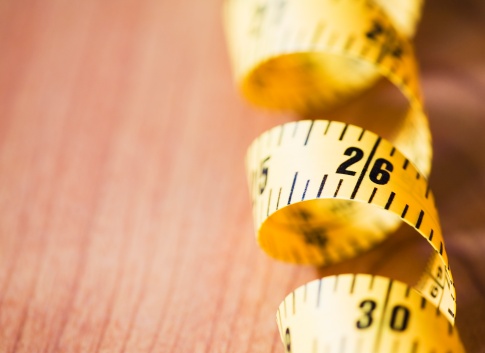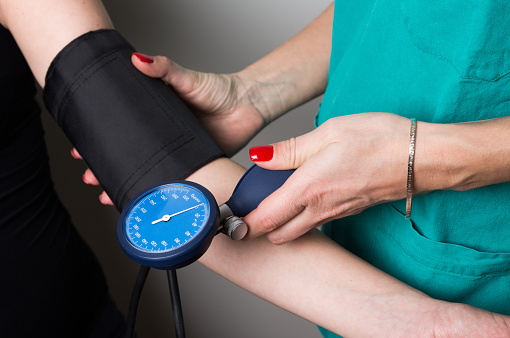For Your Health: 5 Numbers You Need to Know
Article posted in: Lifestyle
Seeing the numbers drop on the scale is uber-satisfying, but did you know there are some other numbers you should be looking at, too? Getting down to your “fighting weight” and staying active are just two ways of measuring your health, but there are other numbers you need to know, like these five:
1. Waist-to-Hip Ratio
Forget BMI or waist circumference. If you want a more accurate way to determine your cardiovascular and metabolic risk, you need to look at your waist-to-hip ratio (WHR). BMI measures how much weight we carry on our frames, but it doesn’t measure where we carry our weight–and that’s important.
“WHR is a measurement tool that looks at the proportion of fat stored on your waist, and hips and buttocks,” according to New York Presbyterian Hospital’s online calculator. “Weight concentrated around the middle is often referred to as an ‘apple’ shape; whereas weight concentrated around your hips is referred to as a ‘pear’ shape.”
What does it matter which piece of produce a person’s body resembles?
For those with a higher WHR (typically an “apple” shape), researchers have found a link between a higher risk of diabetes and hypertension (high blood pressure). A study published in the journal Stroke noted that in a sampling of patients who have had a stroke, a higher WHR was a commonality.
Even someone with an average BMI can have an increased risk of heart disease due to a larger waist circumference. “Normal-weight women with a waist of 35 inches or higher had three times the risk of death from heart disease, compared to normal-weight women whose waists were smaller than 35 inches,” according to Harvard’s School of Public Health.
To find out your WHR, you need to measure your waist circumference and divide that by your hip circumference. (Measuring yourself can be tricky, so you might have to enlist the help of a friend or ask your doctor to measure you at your next checkup.) For example, a waist circumference of 24 inches divided by a hip circumference of 36 inches would result in a WHR of .67.
According to the World Health Organization (WHO), men should maintain a WHR of less than .95 and women, less than .85.
2. Blood Pressure
If you’ve ever had your blood pressure checked, you most likely see two numbers on a machine or a nurse just tells you if it’s “good” or “too high.” So, what is blood pressure really measuring?
The top number is your systolic pressure. It will be the larger of the two numbers and it measures the pressure in your arteries when your heart muscle contracts, according to The American Heart Association (AHA). The bottom number is your diastolic pressure and measures arterial pressure in between heartbeats (when your heart is resting).
The AHA recommends a systolic (top number) of less than 120 and a diastolic (bottom number) of less than 80. Anything higher puts you at an increased risk for hypertension. The AHA lists stage one hypertension at a systolic pressure of 140-159 and a diastolic pressure of 90-99. Also, the closer the two numbers are to each other, the harder your heart is working (which can cause shortness of breath).
Bear in mind, “a single high reading does not necessarily mean that you have high blood pressure,” the AHA says. If you get one high reading, your doctor will take a few more readings and compare your pressure over time. If you were running late to the appointment, your pressure might be higher from the stress of it or from the run from the car to the office door.
If you feel at risk, talk to your doctor. He or she might ask you to take your blood pressure at home. You can ask your doctor to write a prescription for a cuff (depending on what your insurance allows) or just pop into a store like Walgreens or Rite-Aid and get a free reading.
3. Cholesterol
“Cholesterol is a waxy, fat-like substance that’s found in all cells of the body,” according to the National Heart, Lung and Blood Institute, which is part of the National Institutes of Health (NIH). “Cholesterol travels through your bloodstream in small packages called lipoproteins (lip-o-PRO-teens). These packages are made of fat (lipid) on the inside and proteins on the outside.”
There are two types of lipoproteins: Low-density lipoproteins (LDL or “bad” cholesterol) and high-density lipoproteins (HDL “good” cholesterol). High LDL can indicate plaque (cholesterol, calcium and fat) build-up in your arteries giving you a greater chance of heart disease. HDL carries cholesterol from your body to your liver, which then gets rid of it. A higher HDL indicates a lower chance of developing heart disease.
Some cholesterol is needed for the production of hormones and vitamin D. But your body takes care of that. If you haven’t had your cholesterol checked recently, talk to you doctor about it. Cholesterol can be measured with a blood test.
4. Resting Heart Rate
The Mayo Clinic lists a normal resting heart rate for adults as anywhere from 60 to 100 beats a minute. A lower number is an indicator of cardiovascular health, so an Olympian might have a resting heart rate of 40. Most of us are higher than that!
To determine your resting heart rate, check your pulse by either using your index and middle fingers to find the pulse point to the side of your windpipe or place the same two fingers over your radial artery located on the thumb side of your wrist. When you can feel your pulse, clock yourself for 15 seconds and count the number of pulses. Multiply that number by four to get your heart beats per minute.
5. Fasting Blood Glucose
This is a test your doctor can include in a panel of blood tests or it can be done as a finger prick test. Fasting before your blood sugar gets spiked by food or drink gives a true reading of your baseline blood sugar. “A fasting blood sugar level less than 100 mg/dL (5.6 mmol/L) is normal,” according to the Mayo Clinic. “A fasting blood sugar level from 100 to 125 mg/dL (5.6 to 6.9 mmol/L) is considered prediabetes. If it’s 126 mg/dL (7 mmol/L) or higher on two separate tests, you have diabetes.”
Certain factors can put a person at a higher risk of developing diabetes, like a BMI higher than 25, having delivered a baby that weighed nine pounds or more, a family history of diabetes and other factors.
Type 1 diabetes often begins in early childhood. Type 2 diabetes typically develops after the age of 40. Symptoms include: Increased thirst, frequent urination, fatigue, extreme hunger, blurry vision, frequent infections of the gums or skin, slow to heal sores and irritability.
Having a cranky day doesn’t mean you have diabetes, and if you are drinking at least 64 ounces of water a day, you probably visit the loo quite a bit, which is why it is important to talk to your doctor about your risk for diabetes.














